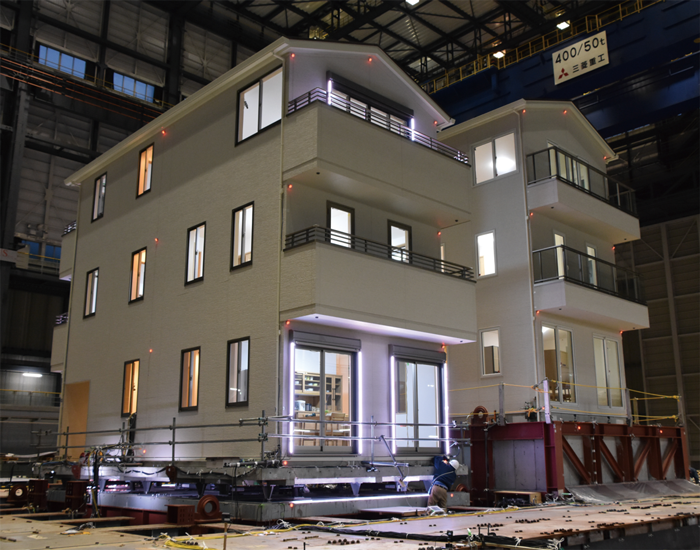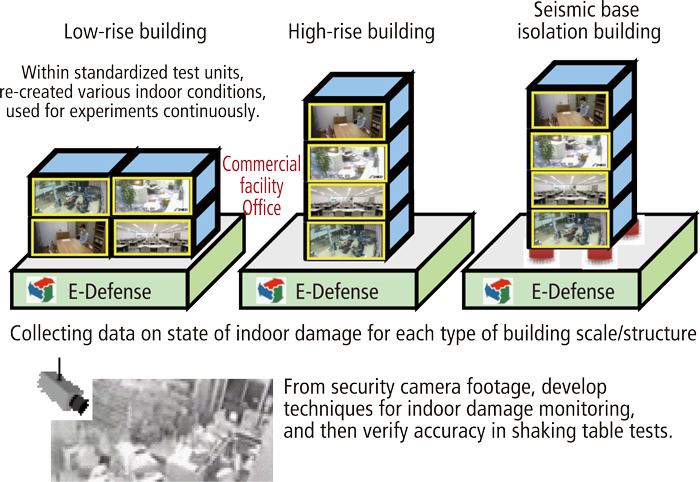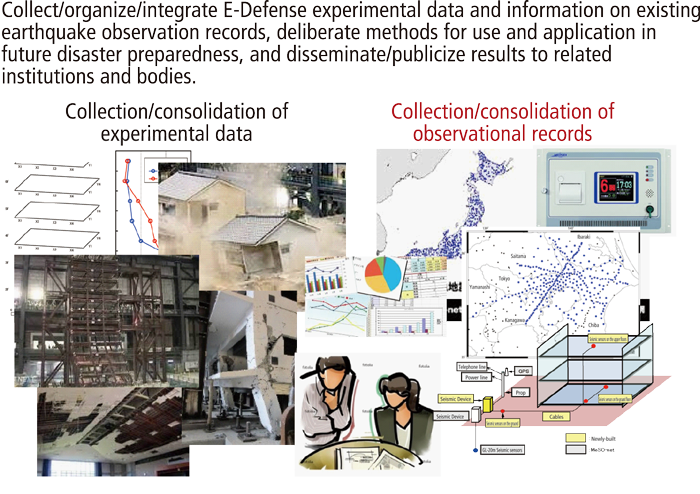R&D Activities - Subprojects(c)
Engineering field Aiming to enhance disaster preparedness
Data collection and consolidation in regard to safety margin to collapse of building structures with non-structural element behavior into account.
Effectively utilizing NIED's 3-D Full-Scale Earthquake Testing Facility (E-Defense), Subproject (c) collects and consolidates those data which would be significant for the judgement of seismic safety margin of buildings and structures with non-structural elements and components taken into account. This project aims at establishing of an effective scheme for: (1) the automatic judgement of the safety of, in particular, those kinds of buildings which could be core hubs for enhancing disaster resilience, such as government buildings, hospitals, gymnasiums, stations supporting the people having difficulty in getting home, thus providing the people with emergency evacuation places; and (2) maintaining the functionality or business continuity of the potentially-backbone buildings and realizing their prompt recovery along with damage identification and recovery and preventing the densely-gathering residential wooden-house areas from disastrous damage. In addition, this subproject identifies the actual seismic effects on buildings considering the mutual interaction of building and soil-foundation, utilizing the data observed under the management of Subproject (b).
Research Themes
1
Broad-zones damage and risk assessment based on broad-spred efficient sensing systems
PI(NIED): Takahito Inoue, Deputy Manager, Earthquake Disaster Mitigation Research Division, NIED
We will conduct R&D for the comprehensive methods to implement broad-zone damage assessment in densely populated residential zones, by integrating holistic data from the maintenance-efficient and also cost-efficient sensors combined with existing broad-band seismic observation networks. We have conducted a series of full-scale E-Defense tests on real wood dwellings, which adopted two representative structures covering the current Japanese constructions. One was the Shear-Wall Structure constructed on a 1.5m-heigh real soil having embedded pipe lines. Another was the Post-and-Beam Structure equipping a high-performance base-isolation system. The functionality loss due to failures of embedded pipe lines was disclosed, while an extreme high-resilience capacity was demonstrated given the base-isolation system. In the ultimate phase, both test dwellings had high-intensity inputs to the foundations, and resulted in near collapse states showing ultimate capacities of building structures. Numerical simulation technologies will be so developed to realize accurate evaluation for the dwellings consisting of structural and nonstructural systems. Instantaneous assessment methods for the damage process as well as the resisting margin to ultimate collapse was implemented by monitoring base on various sensors placed in the test system. The enhancement of broad-zone damage assessment is fulfilled by the calibrated sensor devices and newly established sensing systems as well as sophisticated numerical analyses. Those methods utilizing the sensing technologies significantly enhance existing post-earthquake inspection framework for wood dwellings. That will firmly support the relevant local governments regarding the restoration policies towards seismically damaged residential areas.

2
Rapid evaluation of safety level of disaster resilience hub buildings and rapid determination of feasibility of ongoing usage
We conduct R&D with a view to formulating a system for determining the safety level of buildings immediately after earthquakes, their seismic safety margin, and feasibility for continuous usage, by installing a limited number of sensors inside existing buildings that act as hubs during disasters such as government buildings and gymnasiums. Concretely, this will involve shaking table experiments to shake a real-scale 3-story R/C building that have not only a real structure but also all fixtures and non-structural components. Based on shaking test data from the building detected by sensors, we propose techniques for rapidly evaluating the level of damage from the building frame to all fixtures and non-structural components, and methods for determining feasibility of ongoing usage for equipment based on quantitative evaluation of seismic safety margins.

3
Holistic Seismic Assessment of Critical Buildings with due Consideration of Non-Structural Components and Equipment
PI(NIED): Yohsuke Kawamata, Chief Researcher, NIED
Hospitals registered as “critical” in a regional medical service are expected to remain safe during disasters. This research aims to develop a methodology to evaluate the level of functionality deterioration after earthquakes and identify technologies to support decision-making of facility managers efficiently. A full-scale shake table testing of a hospital building with critical equipment will be conducted to examine a margin to buidling collapse, identify the vulnerability elements in medical services, evaluatoin of seismic resistance to critical equipment, and quantiication of functionality loss in a holistic mannar.

4
Function Maintenance of indoor space
Acting Manager: Kazuhiro Hayashi, Associate Professor, Graduate School of Engineering,Chiba University
Task-team 4 will propose guidelines of verification methods for function maintenance performance, methods for damage countermeasures and earthquake damage sensing techniques regarding non-structural components, indoor equipments, furniture etc.,to maintain the function of building facilities during an earthquake. Concretely, team 4 will construct shaking table test units (This shaking table test units can be used over and over, by not damaging the major structural elements and changing the non-structural components for each experiment) which can reproduce earthquake damage for each type of non-structural components and indoor equipments, will collect and store data regarding damage to non-structural components caused by various types of earthquake ground motions and will examine methods for damage countermeasures and earthquake damage sensing techniques. From these results, team 4 will propose guidelines for verification methods for function maintenance performance.

5
Data collection, consolidation and utilization toward the establishment of identification scheme for building damage states
Task-team 5 conducts four kinds of large-scale model E-Defense shake table tests in corporation with Task-teams 1-4, then collecting and inspecting these obtained experimental data. In addition, Team 5 consolidates various data of formally-conducted E-defense experiments and the actual data being collected by the existing seismic accelerometers. With the above data, Team 5 investigates how to utilize the above data toward building an effective disaster prevention scheme and spreads distribution of such a scheme as well as the data into related organizations and private companies. The above-mentioned activity would contribute to the effective data utilization for enhancing the Tokyo Metropolitan Area seismic resilience. Team 5 takes the role of “Principle Investigator” for the entire Subproject (c) research activities.


